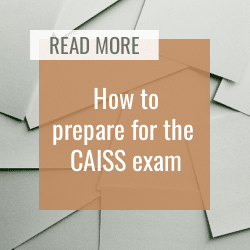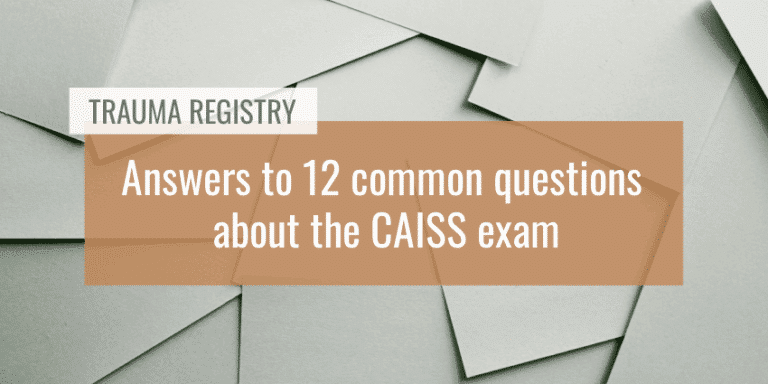In 2024 more than 500 data professionals took the Certified Abbreviated Injury Scale Specialist (CAISS) Examination, the largest one-year total in the history of this program.
As interest in CAISS certification grows, we have been receiving more queries about the test itself and the testing process. Here are answers to a dozen common questions about the CAISS examination.
1. As a trauma registrar, am I required to obtain AIS certification?
According to Standard 4.32 of Resources for Optimal Care of the Injured Patient: 2022 Standards (July 2025 Revision) from the American College of Surgeons (ACS), “In all trauma centers, at least one registrar must be a current Certified Abbreviated Injury Scale Specialist (CAISS).”

Note that the ACS only requires one registrar to sit for and pass the AIS exam, not every member of the registry team.
In addition, although this standard is applicable to Level I, II, III adult centers and Level I and II pediatric centers, it only applies to trauma centers that are verified by the ACS.
Having said that, individual trauma centers may require multiple registry team members to attain AIS certification as a condition of employment.
2. Why is it important to become certified in AIS?
Efforts to improve trauma care depend on quality trauma data — and quality trauma data depends on quality data abstraction. For that reason, the trauma community needs trauma registry professionals with expertise in coding patient injuries using the Abbreviated Injury Scale (AIS).
AIS informs decision-making within numerous healthcare, academic, research and policy settings:
- Healthcare organizations depend on accurate AIS coding for clinical trauma management, outcome evaluation and case mix adjustment purposes.
- Motor vehicle crash investigators use AIS codes to identify mechanisms of injury and improve vehicle design.
- Researchers depend on AIS data for epidemiological studies and systems development, all of which may influence law and regulation.
The oversight of this important data should be provided by an expert. The Certified Abbreviated Injury Scale Specialist is that expert.
As a trauma registrar, the CAISS credential demonstrates your commitment to AIS coding knowledge, application and continued learning. This can help boost your professional credibility and your prestige within your own network.
3. Why do I have to take a test to recertify?
Many professional certifications can be maintained by taking continuing education courses — so why does the CAISS program require individuals to re-test every five years?
As noted above, injury data coded in AIS is foundational for a wide range of patient care, research and policy initiatives. Because of the importance of this data to the healthcare system, ongoing CE is important but not sufficient. To ensure data quality, it is essential to validate the knowledge and application skills of individual AIS coders through a formal, periodic testing process.
4. What is the pass rate for the CAISS exam?
Among individuals attempting to earn an initial CAISS certification, the examination first-attempt pass rate is 75% and the second-attempt pass rate is 42%.
Among individuals attempting to earn their CAISS recertification, the examination pass rate is 93%.
For comparison, the first-time pass rates for other health data certification examinations are:
- Registered Health Information Administrator (RHIA) — between 69% and 75%
- Registered Health Information Technician (RHIT) — between 71% and 84%
- Various AAPC certifications — 70%
Little known fact: There are actually four unique CAISS examinations that are used at various testing sites in rotation.
5. Where can I find information about the exam?
Complete information on the CAISS exam is available in the Candidate Handbook for the Certification Examination for AIS Coding Specialists. This handbook explains everything you need to know about the testing process (application procedures, fees, exam day rules, etc.) and it also includes a detailed outline of the exam content as well as several sample questions.
To access the most recent version of this resource, visit Professional Testing Corporation (the administrator of the CAISS exam) and click the Candidate Handbook link.
6. What subjects does the test cover?
The CAISS examination covers:
| Content area | Percentage of score |
| Anatomy | 20% |
| Medical Terminology as Related to Injury Diagnoses | 10% |
| AIS Coding Fundamentals | 25% |
| Identification and Coding of Injury Descriptions | 45% |
7. What categories are the most challenging?
Test takers who fail the CAISS examination tend to score low in the “Anatomy” and “Identification and Coding of Injury Descriptions” categories.
To increase your ability to do well on these and other sections, we recommend reviewing the exam content outline (found in the Candidate Handbook) and paying extra attention to the terminology, codes, etc., that you use only infrequently.
For example, pay special attention to the anatomical structures that you rarely code (such as arteries and veins) as opposed to anatomy that you code nearly every day (such as pelvis and ribs).
For more test prep ideas and recommendations, read How to prepare for the CAISS exam.
8. What version of the AIS Dictionary is the exam based on?
Through the end of 2025, the CAISS examination will be based on the AIS 2005/2008 Update Dictionary. Beginning in 2026, the exam will be based on the AIS 2015 Dictionary.
If you plan to take the CAISS exam in 2026 or later, be aware that the 2015 dictionary differs in several ways from the previous version, including significant changes to the spine chapter.
9. What are the eligibility requirements for taking the CAISS exam?
CAISS exam candidates must have:
- Earned a minimum of a high school diploma or equivalent
- Submitted a complete Application for the Certification Examination for AIS Coding Specialists
- Paid the required fee
It is highly recommended that candidates have a minimum of 1 year of experience using the AIS.
It is suggested that candidates have successfully completed coursework on:
- Human anatomy
- Medical terminology
- Uses and techniques of injury scaling
10. How often is the exam offered?
Previously, the CAISS exam was offered twice a year. Starting in 2024, the exam is now offered four times a year — in March, June, September and December.
See the latest version of the Candidate Handbook for precise dates.
11. What do I do if I live far from a testing site?
For candidates who live a considerable distance from a testing center, Professional Testing Corporation offers the option of live remote proctoring.
12. Why is testing in person preferred over online testing?
While live remote proctoring is available to those who need it, this option includes several special requirements and restrictions:
- You must provide a computer, a camera, a microphone and a stable internet connection.
- You must ensure you will be in a quiet, distraction-free environment. (The unexpected appearance of anyone, or even a pet, in your testing area will invalidate your exam.)
- You must remain in your testing area throughout the examination period (no breaks).
Taking the CAISS exam at a testing center is preferred because the logistics of connectivity and security are all handled by testing center staff.
Amy Brammer, MSN, RN, TCRN, TNS, CEN, CAISS, CSTR, NHDP-BC is Trauma Program Director at Kaiser Permanente Vacaville Medical Center, a Level II trauma center in Vacaville, CA. She also serves as the chair of the Abbreviated Injury Scale Certification Board and faculty for the Abbreviated Injury Scale Course.
Kathy Cookman, BS, CSTR, CAISS, EMT-P, FMNP is the AIS Business Director and International Technical Coordinator for the Association for the Advancement of Automotive Medicine (AAAM).

